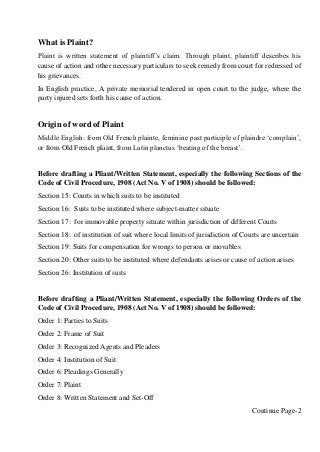
Plaint & Written Statement (WS)
- 1. What is Plaint? Plaint is written statement of plaintiff’s claim. Through plaint, plaintiff describes his cause of action and other necessary particulars to seek remedy from court for redressed of his grievances. In English practice, A private memorial tendered in open court to the judge, where the party injured sets forth his cause of action. Origin of word of Plaint Middle English: from Old French plainte, feminine past participle of plaindre ‘complain’, or from Old French plaint, from Latin planctus ‘beating of the breast’. Before drafting a Pliant/Written Statement, especially the following Sections of the Code of Civil Procedure, 1908 (Act No. V of 1908) should be followed: Section 15: Courts in which suits to be instituted Section 16: Suits to be instituted where subject-matter situate Section 17: for immovable property situate within jurisdiction of different Courts Section 18: of institution of suit where local limits of jurisdiction of Courts are uncertain Section 19: Suits for compensation for wrongs to person or movables Section 20: Other suits to be instituted where defendants arises or cause of action arises Section 26: Institution of suits Before drafting a Pliant/Written Statement, especially the following Orders of the Code of Civil Procedure, 1908 (Act No. V of 1908) should be followed: Order 1: Parties to Suits Order 2: Frame of Suit Order 3: Recognized Agents and Pleaders Order 4: Institution of Suit Order 6: Pleadings Generally Order 7: Plaint Order 8: Written Statement and Set-Off Continue Page-2
- 2. Page-2 Necessary Contents of Plaint Followings are the necessary contents of plaint; (i) Plaint should contain name of that court in which suit is brought. (ii) Plaint should contain name, description and residence of plaintiff. (iii) Plaint should contain name, description and residence of defendant. (iv) When plaintiff or defendant is minor or person of unsound mind, plaint should contain a statement to that effect. (v) Plaint should contain those facts, which have constituted cause of action. In addition to this, it should also be described in plaint when cause of action has arisen. (vi) Plaint should contain those facts, which show the court has jurisdiction. (vii) Plaint should contain that relief, which plaintiff claims. (viii) When plaintiff has allowed set off or has relinquished a portion of his claim, plaint should contain that amount, which has been so allowed or so relinquished. (ix) Plaint should contain statement of value of subject-matter of suit not only for purpose of jurisdiction, but also for purpose of court-fees. (x) Plaint should contain plaintiff’s verification on oath. Parts of Plaint The Plaint has got 8 parts: 1. Cause Title 2. Statements showing cause of action 3. Particular date of cause of action Statement about Jurisdiction 4. Relief or Prayer 5. Valuation of Statement 6. Schedule in the Case of Immovable Property 7. Verification Parts of Written Statement (WS) The Written Statement has got 5 parts: 1. Cause Title 2. Objection as to point of law3 3. Para wise denial 4. Actual Fact 5. Verification Parts of Plaint & Written Statement, 7 Books, Notes, Particulars of a Plaint & Written Statement for Filing and Amendment of Pleadings are for my personal knowledge, and these are not included in this Assignment. Continue Page-3
- 3. Page-3 7 (seven) Books: Before drafting a Pliant/Written Statement, especially the following 7 (seven) the Books (Act/Order) should be followed: 1. The Limitation Act, 19082 2. The Suit Valuation Act, 18873 3. The Court Fees Act, 1870 4. The Code of Civil Procedure, 19085 5. The Civil Rules and Orders (CRO) 6. The Civil Courts Act, 1877. 7. Relevant Laws like The Specific Relief Act, 1877 or others, but in case of Special Laws there needs Special Laws like Artha Rin Adalat Ain, 2003. Notes: For Pre-emption, Petition is to be filed under the State Acquisition and Tenancy Act, 1950 (SAT Act) or Non-Agricultural Tenancy Act, 1949 (NAT Act) and ends with an Order, but the Pre-emption under Muslim Law is a suit. In that case, plaint is filed and ends with decree. In the matter of Criminal cases all are Petition, but in the matter of Civil all are Suit. Particulars of a Plaint for Filing 1. Plaint 2. Firisti Form with all supporting Documents with date 3. Process Fee-Minimum 2 Taka 4. A copy of Plaint is to submit for each Defendant 5. Summons, 3 Copies for each Defendants (a) Served by Peada, (Pricess lserver) (b)Served by Post Office Copy (Reserved in the office with paint) 6. Postal Stamp with Registered with A/D form and Postal Stamp of 8 Taka 7. Vokalatnama Particulars of a Written Statement (WS) for Filing 1. Written Statement 2. Firisti Form with all supporting Documents with date 3. 3 copy of Written Statement for each Plaintiff 4. Vokalatnama Continue Page-4
- 4. Page-4 Amendment of Pleadings Amendment of pleading is possible in any stage of the suit with the permission of the Court. Order VI, Rule 17 of the Code of Civil Procedure, 1998. Even amendment of Pleading is also possible in appeal stage, but it must be before delivery of judgment. Conclusion To conclude, it can be stated that plaint plays important role throughout whole trial of any civil suit. It is admitted principle that no plaintiff can go beyond his plaint. Therefore, no plaintiff can demand what is not claimed in his plaint. Similarly, no plaintiff can produce any evidence, which is beyond his plaint. ARNAB | PCIU | LAW | arnab@legislator.com | www.slideshare.net/arnabbd/presentations
